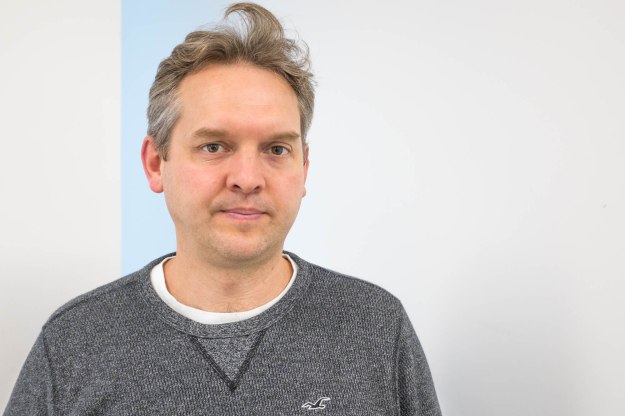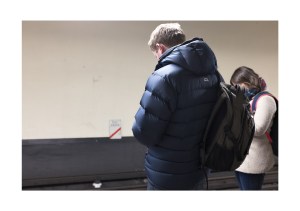
portrait of the artist in London, in battered, red converse (august 2018)
1: Demonstration of technical and visual skills
Compositionally my submission for this final assignment consists of a set of images that are consistent both compositionally and in terms of subject matter. These are competent, engaging pictures that work well as a set while displaying a good variety of individual subjects.
Running through my work for this module, there is a strand of pictures taken in low, irregularly coloured light, usually without the option of using flash to balance things out; these represent my best response to these difficult conditions to date, I think. I have been able to maintain a constant colour palette for each of the two underground lines’ trains; the pictures are sharp and display control of focus to concentrate on the picture’s subject matter.
I find that the pictures hold my attention (and that of others) – I am drawn in and think about what it is that I’m looking at. It is not an overly-serious body of work, but I find I can look at the individual pictures and wonder about what the rest of the person looks like for longer than I thought I would as I was taking the pictures and editing them down to a final set.
2: Quality of outcome
The assignment brief ends: ‘The only stipulation is that the final outcome must represent a notion of identity and place that you are personally inspired by. Make sure that your work is visually consistent, relevant to the subject matter you choose and holds together well as a set, both visually and conceptually‘ (IaP coursebook, p.115). I think I have achieved this.
Before Christmas last year, tutor Clive White said the first of two things about typologies that I found helpful enough to bookmark. It dealt with some of the technical work involved in making typologies:
‘…it helps if the images have the accuracy of a technical drawing; each with the same aspect ratio and size and perspective corrected. It emphasises that they’re all intended to belong to a class, the class of radiator‘ [the discussion was prompted by six grid-presented pictures of iron radiators by fellow student Stefan J Schaffeld]. ‘You can make those corrections in Photoshop‘
…which is pretty much what I did when it came to this work. As I took the pictures, I had a firm image of what the finished images would look like and I was able to achieve this using the tools at my disposal, although I used Photoshop’s younger cousin, Lightroom, for corrections rather than Photoshop itself.
3: Demonstration of creativity
The second bookmarked quote came from a discussion thread in April this year (Formalism and the Bechers) and was to do with the mindset behind making typologies:
‘The Becher’s focussed on typologies; like collecting cigarette and tea cards back in the day or football stickers these days.’
I collected Brooke Bond tea cards (and sent off for the albums to keep them in) when I was a boy; I am currently collecting the Lego cards that are being given away at Sainsbury’s. This seems to be something deeply embedded in my make-up.
There was a period when I was travelling to and from Moscow quite often, early this century. Waiting for the flight out from London (or for the flight home), I became aware that the people who lived in the Russian Federation almost all had square-toed shoes, while the fashion in shoes in the UK was for rounded. What you had on your feet could be used to locate you. At the same time, I was often slightly startled by the way people in shops or restaurants would greet me in English without my having given myself away with my heavily accented Russian. I assumed it was something to do with one of the things Bate categorises – the face, the pose, the clothes; maybe it was my round-toed shoes…
This is a project I can repeat, making variations on a theme. I still travel a fair bit, and many of the places I travel to have an underground (or a metro or a subway). I try to use public transport rather than taxis wherever I am. The next time I’m in Paris (possible), Berlin (scheduled for October) Kyiv (likely at some point) Sao Paulo (much less likely) or Glasgow (inevitable), I could spend some time photographing my fellow traveller’s feet, producing further partial portraits of particular places, at particular moments in time. I could also take further sets of pictures in London as the seasons change. The difficulty would be to keep it fresh rather than taking the pictures becoming just another thing that I do when I arrive somewhere with an underground railway.
What this assignment continues is my habit of taking photographs on the move as I go about my day-to-day life. I hope they also demonstrate curiosity.
4: Context
The shoe project draws from all the sections of this course module: the bit of work from part one that stood out for my tutor was my typology of smokers; much of my reading for part two was concentrated on photographs taken on metros and subways and the London underground; my third assignment featured a tube journey and began the examination of myself as a city-dwelling public-transport user that continues here; the captioning of the individual pictures ties in with part four even if it does not draw on the fourth assignment itself.
It is harder to see how it relates to the final section on Removing the Figure, although there are no faces to be seen. I have however found a lot to think about and use in future projects during this section of the course; I think still lifes will play a significant part in my work for my next course. My original idea for this last assignment (dropped for boringly practical reasons) was to identify playground furniture with childhood and park benches with being a parent and would probably have been a better fit, but since we are instructed to draw on all parts of the module, I think this is alright!
Where it does draw on part five is its use of a figure of speech – synecdoche, rather than metaphor, as in research point 1 – as a structuring principle. The danger with synecdoche is that – in reducing a whole person to a specific part or function – there is always a danger of objectification. ‘Farm hands’ are likely to seem less rounded as a person than the farmer who hire; a woman described as ‘a nice piece of ass’ is not going to be asked about her views on Wittgenstein by the person doing the describing.
I did not intend the people who’s feet I had taken pictures of to be reduced by the process or to be seen as ‘other’. I firmly fit into the same category or class – commuters – as they do. Perhaps I should have included a picture taken after asking someone sitting opposite me to take a picture my feet as well and included it in the set but I couldn’t summon up the courage to commission someone to do so in the course of my daily trips to and from work. By way of partial recompense for this, I include a self portrait at the top of this post. The feet point the other way, but they still show me, there on the tube with all the others…
Reference:












